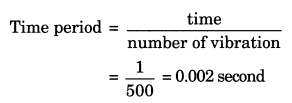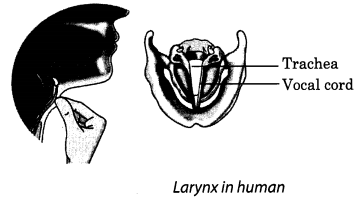Solutions For All Chapters Science Class 8
Question 1.
Choose the correct answer.
Sound can travel through
(a) gases only
(b) solids only
(c) liquids only
(d) solids, liquids, and gases
Answer: (d) solids, liquids, and gases.
Question 2.
Voice of which of the following is likely to have a minimum frequency?
(a) Baby girl
(b) Baby boy
(c) A man
(d) A woman
Answer: (c) A man
Question 3.
In the following statements, tick ‘T’ against those which are true and ‘F’ against those which are false
1. Sound cannot travel in a vacuum.
2. The number of oscillations per second of a vibrating object is called its time period.
3. If the amplitude of vibration is large, the sound is feeble.
4. For human ears, the audible range is 20 Hz to 20,000 Hz.
5. The lower the frequency of vibration, the higher is the pitch.
6. Unwanted or unpleasant sound is termed as music.
7. Noise pollution may cause partial hearing impairment.
Answer:
1. True
2. False
3. False
4. True
5. False
6. False
7. True
Question 4.
Fill in the blanks with suitable words.
1. Time taken by an object to complete one oscillation is called _______
2. Loudness is determined by the ________ of vibration.
3. The unit of frequency is ________
4. Unwanted sound is called _______
5. The shrillness of a sound is determined by the ______ of vibration.
Answer:
1. Time period
2. Amplitude
3. Hertz (Hz)
4. Noise
5. Frequency
Question 5.
A pendulum oscillates 40 times in 4 seconds. Find its time period and frequency.
Answer:
No. of oscillation = 40
Total time is taken = 4 seconds
Question 6.
The sound from a mosquito is produced when it vibrates its wings at an average rate of 500 vibrations per second. What is the time period of the vibration?
Answer:
Number of vibrations per second = 500
Question 7.
Identify the part which vibrates to produce sound in the following instruments.
1. Dholak
2. Sitar
3. Flute
Answer:
1. Stretched membrane
2. String of sitar
3. Air column
Question 8.
What is the difference between noise and music? Can music become noise sometimes?
Answer:
The type of sound which are unpleasant to listen is known as noise whereas music is a pleasant sound, which produces a sensation.
Yes, music can become noise when it’s too loud.
Question 9.
List the sources of noise pollution in your surroundings.
Answer:
Following are the major sources of noise pollution:
1. Sound of vehicles
2. Sound of kitchen appliances
3. Sound of bursting crackers
4. Sound of loudspeakers, TV, transistors
Question 10.
Explain in what way noise pollution is harmful to humans.
Answer:
Noise pollution causes:
(a) Lack of sleep
(b) Anxiety
(c) Hypertension
and these are harmful to health.
Question 11.
Your parents are going to buy a house. They have been offered one on the roadside and another three lanes away from the roadside. Which house would you suggest your parents should buy? Explain your answer.
Answer:
I would suggest my parents buy a house three lanes away from the roadside because house on the roadside would be much noisy in both days and night due to running vehicles. Whereas, a house three lanes away would be comparatively quieter as the intensity of noise decreases with the distance between the source and the listener.
Question 12.
Sketch larynx and explain its function in your own words.
Answer:
Larynx is also known as voice box. It is at the upper end of the windpipe. Two vocal cords are stretched across the voice box or larynx in such a way that it leaves a narrow slit between them for passage of air (Fig. 13.12). When lung force air through the slit, the vocal cords vibrate, producing sound. Muscles attached to the vocal cords can make the cords tight or loose.
When the vocal cords are tight and thin, the type or quality of voice is different from that when they are loose and thick.
Question 13.
Lightning and thunder take place in the sky at the same time and at the same distance from us. Lightning is seen earlier and thunder is heard later. Can you explain why?
Answer:
The speed of light is more than that of the speed of sound. Thus, due to more speed of light it reaches us before sound. So, lightning is seen earlier and thunder is heard later.




Super excellent
Very nice answers how written
📘📘
Very nice 👌
All answers are correct.
Helpful for students